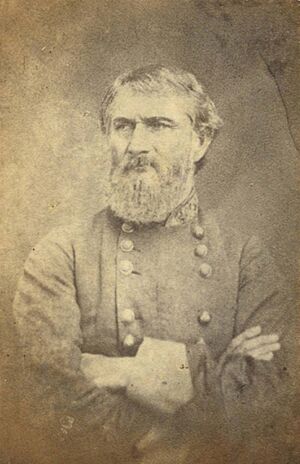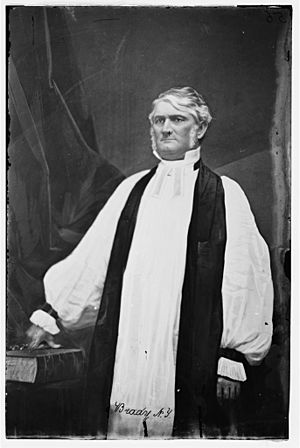Leonidas Polk facts for kids
Quick facts for kids
Leonidas Polk
|
|
|---|---|

Polk in uniform, c. 1862
|
|
| Nickname(s) | "Sewanee's Fighting Bishop", "Bishop Polk" |
| Born | April 10, 1806 Raleigh, North Carolina, US |
| Died | June 14, 1864 (aged 58) Cobb County, Georgia, US |
| Place of burial | |
| Allegiance | |
| Service/ |
|
| Years of service | 1827 (U.S.) 1861–1864 (C.S.) |
| Rank | |
| Commands held | First Corps, Army of Tennessee Army of Mississippi Third Corps, Army of Tennessee |
| Battles/wars | American Civil War |
| Signature | |
| Leonidas Polk | |
|---|---|
| Bishop of Louisiana | |
 |
|
| Church | Episcopal Church |
| Diocese | Louisiana |
| Elected | October 16, 1841 |
| In Office | 1841–1864 |
| Successor | Joseph Pere Bell Wilmer |
| Orders | |
| Ordination | May 22, 1831 |
| Consecration | December 8, 1838 by William Meade |
Lieutenant-General Leonidas Polk (born April 10, 1806 – died June 14, 1864) was an American Confederate military leader. He was also a bishop in the Episcopal Diocese of Louisiana and helped start the Protestant Episcopal Church in the Confederate States of America. This church broke away from the main Episcopal Church in the United States.
Polk was a large planter in Maury County, Tennessee, and a distant relative of President James K. Polk. He left his church position to become a major-general in the Confederate States Army. People sometimes called him "Sewanee's Fighting Bishop." His official picture at the University of the South shows him as a bishop with his army uniform nearby.
Even though he didn't have much combat experience, Confederate president Jefferson Davis gave him a high military role. Polk led troops in important battles like Battle of Shiloh, Battle of Perryville, and Battle of Chickamauga. He was known for having disagreements with his commander, General Braxton Bragg. Polk was killed in action in 1864 during the Atlanta Campaign.
Contents
Early Life and Education
Leonidas Polk was born in Raleigh, North Carolina. His parents were Colonel William and Sarah Polk. William was a veteran of the American Revolutionary War and a successful landowner. The family had Scottish and Anglo-Huguenot roots.
Polk briefly attended the University of North Carolina at Chapel Hill. Then, he went to the United States Military Academy at West Point. During his last year there, he joined the Episcopal Church. He graduated eighth in his class on July 1, 1827. He became a brevet second lieutenant in the artillery.
Polk left the military on December 1, 1827. He decided to study at the Virginia Theological Seminary to become a priest. He was ordained as a deacon in 1830 and a priest the next year. On May 6, 1830, Polk married Frances Ann Devereux. They had eight children who grew up.

In 1832, Polk moved his family to a large property in Maury County, Tennessee. He built a big home called Ashwood Hall. He owned a large plantation where enslaved people worked. He also helped build a family chapel, St. John's Church, at Ashwood. He became the first Bishop of Louisiana in 1841.
Polk was a main founder of the University of the South in Sewanee, Tennessee. He imagined it as a major university for the Southern United States. He laid the first stone for the university's first building on October 9, 1860. His portrait, Sword Over the Gown, shows how he saw his duty as a bishop to also take up arms.
American Civil War Role
Starting the War in Kentucky
When the Civil War began, Polk led the Louisiana church to separate from the main Episcopal Church. He offered his help to his friend, Jefferson Davis, who was the Confederate president. Polk became a major general on June 25, 1861. He was put in charge of a large area between the Mississippi River and the Tennessee River.
Polk made a big mistake by sending troops to occupy Columbus, Kentucky, in September 1861. Kentucky had said it would stay neutral in the war. But Polk's action made Kentucky ask the U.S. for help. This helped the U.S. keep control of Kentucky for the rest of the war.
Polk's troops first fought on November 7, 1861, at the Battle of Belmont. This was a small battle against U.S. soldiers led by Brig. Gen. Ulysses S. Grant. Polk was hurt a few days later when a large cannon, named "Lady Polk" after his wife, exploded.
Leading the Army of Mississippi
In April 1862, Polk led the First Corps of Albert Sidney Johnston's Army of Mississippi at the Battle of Shiloh. He continued in this role under other generals, including Braxton Bragg. During the fall, Polk was in temporary command of the Army of Mississippi.
At the Battle of Perryville, Polk's troops were the main attacking force. There's a famous story from this battle. Polk heard his officer, Maj. Gen. Benjamin F. Cheatham, tell his soldiers, "Give 'em hell, boys!" Polk then added, "Give it to 'em, boys; give 'em what General Cheatham says!"
Challenges in the Army of Tennessee
After Perryville, Polk tried to get General Bragg removed from command. Polk was promoted to lieutenant general on October 11, 1862. He became the second highest-ranking Confederate general of that rank. In November, his army was renamed the Army of Tennessee.
Polk fought under Bragg at the Battle of Stones River in late 1862. After this battle, Bragg's officers again tried to get him removed. Bragg was also unsuccessful in stopping the U.S. army's advance in the Tullahoma Campaign. Polk advised Bragg to retreat instead of fighting in their defenses.
Later, Bragg was forced out of Chattanooga. Polk's troops failed to attack an isolated U.S. Army corps as ordered. At the Battle of Chickamauga, Polk was supposed to start the attack on the second day. But he was late, which gave the U.S. defenders time to build up their defenses. Bragg was very upset and removed Polk from his command.
Command in Mississippi and Death
President Davis then moved Polk to command the Department of Mississippi and East Louisiana. In May 1864, Polk was ordered to join General Joseph E. Johnston in Georgia. They were trying to stop Maj. Gen. William Tecumseh Sherman's advance in the Atlanta Campaign. Polk took command of the Third Corps of the Army of Tennessee.
Polk brought over 20,000 men with him to Georgia. Because of his high rank, he became the second-in-command under Johnston. Sherman's army kept forcing Johnston's army to retreat closer to the important city of Atlanta.
On June 14, 1864, Polk was looking at enemy positions near Marietta, Georgia. He was with other generals and their staff. Sherman saw them in an open area and ordered his troops to fire. A U.S. artillery shell hit Polk, killing him instantly. It was a sad day for the Confederate army.
Polk's Legacy
Even though his military record had its ups and downs, Polk was very popular with his soldiers. His death was deeply mourned by the Army of Tennessee. His funeral service in Augusta, Georgia, was one of the most detailed during the war. He was buried there, but in 1945, his remains were moved to Christ Church Cathedral, New Orleans in New Orleans.
Fort Polk in Louisiana was named after him for many years, but it was renamed Fort Johnson in 2023.
Polk's nephew, Lucius E. Polk, was also a Confederate general. His son, William Mecklenburg Polk, was a doctor and a Confederate captain. He later wrote a biography about his father.
See also
- List of Confederate States Army generals
- List of people from Raleigh, North Carolina
Images for kids

